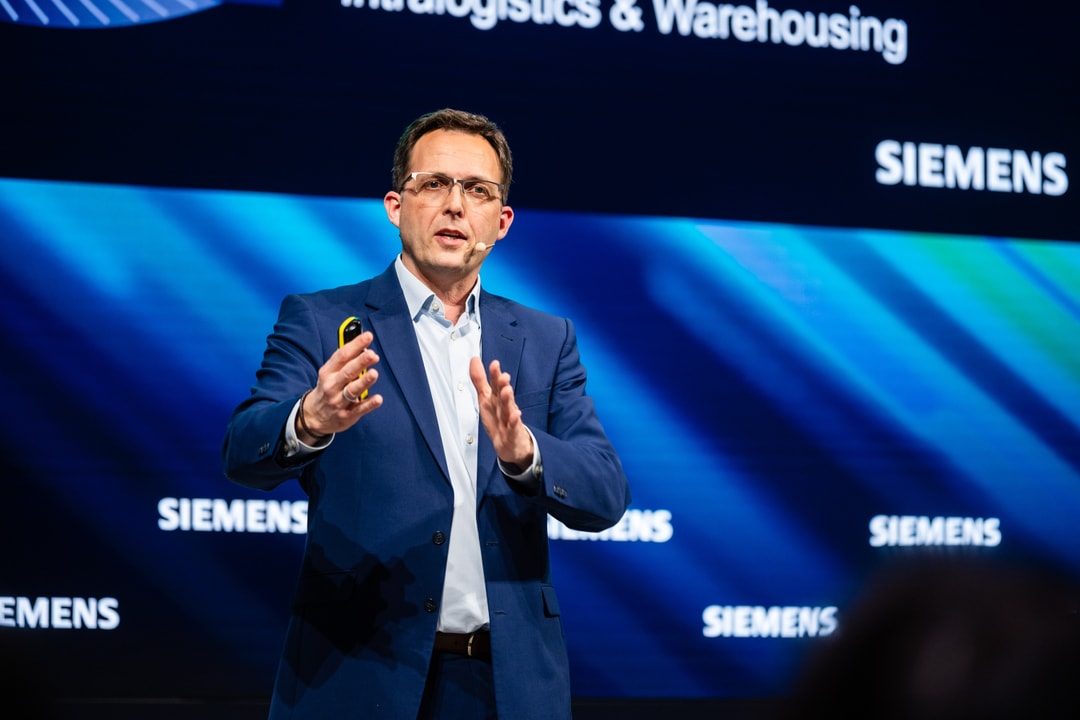Shift-left logistics: The key to a profitable and sustainable supply chain

The future of supply chain management lies in embracing circular economy principles to address material shortages, Environmental, Social and Governance (ESG) regulations and rising risks. In his Hannover Messe 2025 presentation “How shift-left logistics is paving the way to a resilient circular economy” Volker Albrecht, CEO of Siemens Digital Logistics, outlined an innovative approach to supply chain management: Shift-Left Logistics. This concept challenges traditional supply chain thinking by integrating logistics considerations at the earliest stages of product design. By doing so, it lays the foundation for a resilient circular economy – an economy where materials are continuously reused, reducing waste and emissions while improving business efficiency and profitability.
The need for a paradigm shift
Supply chain emissions – often referred to as Scope 3 emissions – are a staggering 26 times higher than direct operational emissions. Despite global sustainability efforts, only 8.6% of materials entering the economy are currently recycled. This means most resources are still being wasted, either through inefficient design or supply chain bottlenecks.
The circular economy presents a solution. By rethinking logistics from the ground up, companies can significantly reduce waste, optimize resource use and embed sustainability into their operations. Even better, embracing circularity isn’t just about environmental responsibility – it’s a major economic opportunity. Companies that integrate circularity early in their supply chain strategies can unlock significant cost savings, new revenue streams, and competitive advantages. But how can businesses practically implement this transformation? The answer lies in shifting left – bringing supply chain and logistics into the earliest phases of product development.
Moving from “Design for Product” to “Design for Supply Chain”
Traditionally, product design has focused on functionality and aesthetics, with logistics and supply chain considerations coming into play only after the product is developed. However, this outdated approach leads to inefficiencies, increased costs, and unnecessary emissions. Shift-left logistics turns this model on its head.
By integrating logistics data into the product design phase, businesses can make smarter decisions from the start. Considerations such as sourcing recycled materials, optimizing transport routes and reducing packaging waste can all be factored in early, rather than retrofitted later. This approach not only enhances sustainability but also improves cost efficiency and business agility.
The role of digital transformation
Digitalization is a key enabler of Shift-Left Logistics. By leveraging data-driven insights, companies can simulate supply chain scenarios, predict bottlenecks, and make informed trade-offs between cost, sustainability, and risk. Technologies such as digital twins allow businesses to create virtual models of their supply chains, providing real-time visibility and optimization opportunities across multiple touchpoints – from sourcing and production to distribution and recycling.
For example, companies can optimize transportation by consolidating shipments, selecting more sustainable transport modes and ensuring that deliveries align seamlessly with production schedules. By having a digital representation of their entire supply chain, organizations can shift from reactive decision-making to proactive design, improving resilience and efficiency.
Circularity as a business imperative
Beyond sustainability, the circular economy represents a significant economic opportunity. In 2022, circular economy transactions generated approximately $339 billion in revenue. By 2026, this figure is projected to rise to $713 billion – a 110% increase. Companies that integrate circular practices early on are not only future-proofing their operations but also positioning themselves for financial growth. These and more interesting figures can be found in our latest infographic.
Shift-Left Logistics plays a critical role in enabling circularity. By designing products with reusability and recyclability in mind, businesses can extend product lifecycles, reduce dependency on virgin materials and create new revenue streams through remanufacturing and refurbishment.
The Path Forward
The transition to a resilient circular economy requires a fundamental shift in how companies approach logistics and supply chain management. By embracing Shift-Left Logistics, businesses can reduce emissions, improve efficiency and unlock new value streams. The combination of digital transformation and early-stage logistics integration offers a powerful way forward, ensuring that sustainability and profitability go hand in hand.
As Volker Albrecht concluded in his presentation, the future of logistics isn’t just about transporting goods more efficiently – it’s about reimagining the entire supply chain from the very beginning. Those who embrace this shift will not only reduce their environmental footprint but also gain a competitive edge in an increasingly resource-conscious world.
Learn More
To dive deeper into the Shift-Left Logistics concept and how it can transform your supply chain, download our infographic and white paper.


